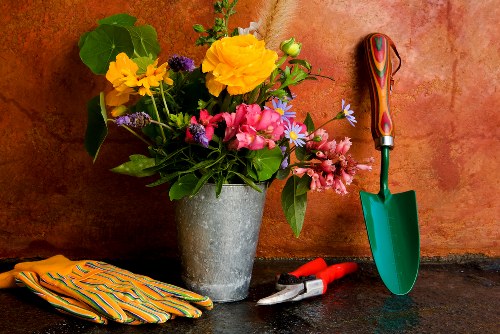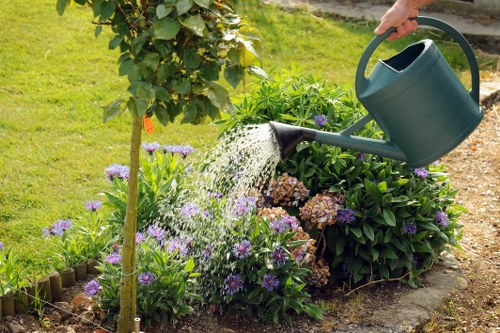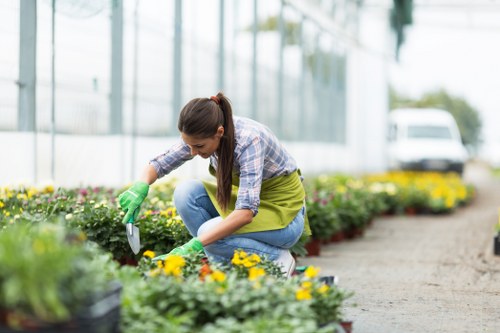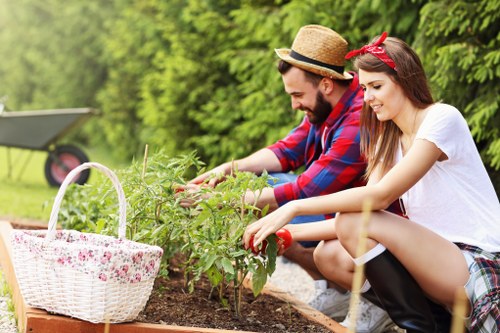Comprehensive Guide to Garden Maintenance in Willesden
Introduction to Garden Maintenance

Maintaining a beautiful garden in Willesden requires dedication, knowledge, and the right approach. Whether you're a seasoned gardener or a novice, understanding the essentials of garden maintenance can transform your outdoor space into a vibrant and welcoming area.
Garden maintenance not only enhances the aesthetic appeal of your home but also contributes to the overall health and well-being of the environment. Proper care ensures that your plants thrive, pests are managed, and your garden remains a sanctuary throughout the year.
In Willesden, the climate and local conditions play a significant role in how you should approach garden maintenance. Tailoring your strategies to the specific needs of your garden will yield the best results.
Seasonal Garden Maintenance

Spring
Spring is a critical time for garden maintenance. As the weather warms up, it's the perfect opportunity to prepare your garden for the growing season.
Tasks to Perform:
- Prune dead or damaged branches to encourage healthy growth
- Plant new flowers and vegetables to add color and produce
- Fertilize your soil to provide essential nutrients for plants
Summer
Summer brings intense heat and often unpredictable weather patterns. Maintaining your garden during this season focuses on ensuring plants receive adequate water and protection.
Key Maintenance Activities:
- Regularly water plants, preferably in the early morning or late evening
- Weed your garden to reduce competition for nutrients
- Implement pest control measures to protect your plants
Essential Garden Tools

Having the right tools is fundamental to effective garden maintenance. Quality tools can make tasks easier and more efficient.
Must-Have Tools:
- Lawn Mower: Keeps your grass tidy and healthy
- Pruning Shears: Ideal for trimming and shaping plants
- Garden Hose: Essential for watering your plants adequately
Additional Tools:
Other useful tools include a spade, rake, wheelbarrow, and gloves. Investing in good-quality tools will ensure durability and better performance.
Soil Health and Fertilization

Healthy soil is the foundation of a thriving garden. Understanding soil composition and nutrition can significantly impact the growth of your plants.
Improving Soil Quality
Regularly testing your soil can help you understand its pH levels and nutrient content. Based on the results, you can amend the soil accordingly.
Types of Fertilizers:
- Organic Fertilizers: Such as compost and manure, which improve soil structure
- Inorganic Fertilizers: Provide specific nutrients quickly but may require careful application
Pest and Disease Management

Protecting your garden from pests and diseases is crucial for maintaining plant health. Early detection and effective management strategies can prevent widespread issues.
Common Pests in Willesden
Slug infestations, aphids, and caterpillars are some of the most common pests that affect gardens in Willesden. Identifying these pests early helps in managing them before they cause significant damage.
Effective Management Strategies:
- Biological Control: Introducing natural predators like ladybugs to control aphid populations
- Cultural Practices: Rotating crops and removing diseased plants to prevent pest buildup
- Chemical Controls: Using pesticides judiciously to minimize environmental impact
Watering Strategies
Effective watering is key to a healthy garden. Both overwatering and underwatering can harm your plants, so finding the right balance is essential.
Best Practices for Watering
Techniques:
- Drip Irrigation: Provides targeted watering directly to the plant roots, reducing water waste
- Soaker Hoses: An efficient way to water rows of plants evenly
- Rainwater Harvesting: Collecting rainwater to use for garden irrigation is both eco-friendly and cost-effective
Watering Schedule
Establishing a consistent watering schedule based on the specific needs of your plants and the local climate ensures optimal growth and health.
Pruning and Trimming
Regular pruning and trimming are essential for maintaining the shape and health of your plants. It encourages new growth and prevents overgrowth that can lead to disease.
When to Prune
The best time to prune most plants is during the dormant season, typically in late winter. However, specific plants may require pruning at different times.
Pruning Techniques:
- Thinning: Removing entire branches to reduce density and improve air circulation
- Heading: Cutting back to encourage bushier growth
- Cleaning: Eliminating dead or diseased wood to maintain plant health
Weed Control

Weeds compete with your garden plants for nutrients, water, and light, making effective weed control a critical aspect of garden maintenance.
Manual Weed Removal
Hand-pulling weeds is a straightforward method but can be time-consuming. It's most effective when weeds are young and before they set seed.
Using Mulch
Applying a layer of mulch around plants helps suppress weed growth, retain soil moisture, and improve soil health.
Herbicides
Chemical herbicides can be used for larger infestations but should be applied carefully to avoid harming desirable plants.
Plant Selection and Arrangement

Choosing the right plants and arranging them thoughtfully can enhance the beauty and functionality of your garden.
Selecting Plants for Willesden
Consider the local climate, soil type, and sunlight when selecting plants. Native plants are often more resilient and require less maintenance.
Arrangement Tips
- Group plants with similar water and light needs together
- Incorporate a mix of perennials and annuals for continuous blooms
- Use vertical gardening techniques to maximize space and add visual interest
Lawn Care

A well-maintained lawn is a cornerstone of any beautiful garden. Proper lawn care involves regular mowing, aeration, and fertilization.
Mowing Techniques
Set your mower to the appropriate height to promote healthy grass growth. Avoid cutting more than one-third of the grass height at a time to prevent stress.
Aeration and Fertilization
Aerating your lawn helps improve soil structure and nutrient uptake. Fertilizing provides essential nutrients that promote lush, green grass.
Garden Design and Layout
Thoughtful garden design can enhance both the functionality and aesthetic appeal of your outdoor space.
Design Principles
Balance and Symmetry
Creating a balanced garden layout ensures visual harmony. Symmetrical designs often appear more formal, while asymmetrical layouts can feel more natural.
Focal Points
Incorporate focal points such as sculptures, water features, or standout plants to draw the eye and add interest to your garden.
Pathways and Borders
Pathways provide structure and guide visitors through your garden, while borders help define different areas and keep plants organized.
Hardscaping Elements
Incorporating hardscaping elements like patios, decks, and fences can enhance the functionality and aesthetics of your garden.
Types of Hardscaping
- Patios: Perfect for outdoor seating and entertaining
- Decks: Provide elevated spaces for relaxation
- Fences: Offer privacy and define garden boundaries
Choosing Materials
Select materials that complement your garden style and are suitable for the local climate. Popular choices include stone, wood, and metal.
Lighting for Your Garden
Proper lighting can transform your garden, making it enjoyable even after dark and highlighting key features.
Types of Garden Lighting
- Path Lights: Illuminate walkways for safety and aesthetics
- Spotlights: Highlight specific plants or architectural features
- String Lights: Create a warm and inviting atmosphere for outdoor gatherings
Energy-Efficient Options
Consider using solar-powered or LED lights to reduce energy consumption and minimize your environmental footprint.
Installation Tips
Plan the placement of your lights carefully to avoid overshadowing plants and ensure even distribution for maximum effect.
Composting and Waste Management
Effective composting and waste management practices contribute to a sustainable garden by recycling organic materials and reducing landfill waste.
Starting a Compost Pile
Collect kitchen scraps, garden waste, and other organic materials to create a rich compost that enhances soil fertility.
Benefits of Composting
- Reduces the need for chemical fertilizers
- Improves soil structure and moisture retention
- Supports beneficial soil microorganisms
Managing Garden Waste
Properly disposing of garden waste, such as pruned branches and dead plants, helps prevent the spread of pests and diseases.
Maintaining Garden Structures
Garden structures like sheds, greenhouses, and trellises require regular maintenance to ensure their longevity and functionality.
Inspection and Repairs
Regularly inspect garden structures for signs of wear and tear. Addressing minor issues promptly can prevent major repairs in the future.
Cleaning and Protection
Keep structures clean and apply protective coatings to wooden elements to guard against moisture and pests.
Creating a Sustainable Garden
Sustainability is becoming increasingly important in garden maintenance. Implementing eco-friendly practices can benefit both your garden and the environment.
Eco-Friendly Practices
- Use native plants to support local wildlife and reduce water usage
- Implement rainwater harvesting systems for efficient irrigation
- Reduce chemical use by opting for organic fertilizers and natural pest control methods
Benefits of a Sustainable Garden
A sustainable garden promotes biodiversity, conserves resources, and creates a healthier ecosystem for both plants and beneficial insects.
Professional Garden Maintenance Services
For those who prefer assistance, professional garden maintenance services in Willesden offer expertise and convenience.
Benefits of Hiring Professionals
Expertise and Knowledge
Professional gardeners bring valuable knowledge of local climate conditions and plant care, ensuring your garden thrives.
Time-Saving
Outsourcing garden maintenance frees up your time, allowing you to enjoy your garden without the hassle of upkeep.
Choosing the Right Service
When selecting a garden maintenance service, consider their experience, range of services, and customer reviews to ensure you receive quality care.
Conclusion
Effective garden maintenance in Willesden involves a combination of regular care, proper tools, and sustainable practices. By understanding the unique requirements of your garden and implementing these strategies, you can create a beautiful and thriving outdoor space.
Take Action Today
Ready to transform your garden? Contact us today to learn more about our garden maintenance services and start your journey toward a stunning garden in Willesden.